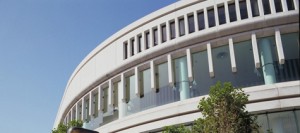In this post, Susan Key—special projects director for the San Francisco Symphony—examines the role the physical concert hall plays in creativity. It’s a question inspired by tonight’s performance by Mason Bates at Davies Symphony Hall in San Francisco. Join us tomorrow for our live event with Mason Bates!
 Tonight, Mason Bates wears two very different hats at Davies Symphony Hall. First, he will appear onstage with the San Francisco Symphony Chorus and organist Paul Jacobs to perform his new composition, Mass Transmission. Once the concert is over, he’ll move to the Second Tier lobby-turned-lounge for an event called Davies After Hours. In a nightclub-like atmosphere, he’ll spin electronic tracks and beats as “DJ Masonic” with friends David Arend on upright bass, Aaron Kahn on trumpet and Gloria Justen on electric violin.
Tonight, Mason Bates wears two very different hats at Davies Symphony Hall. First, he will appear onstage with the San Francisco Symphony Chorus and organist Paul Jacobs to perform his new composition, Mass Transmission. Once the concert is over, he’ll move to the Second Tier lobby-turned-lounge for an event called Davies After Hours. In a nightclub-like atmosphere, he’ll spin electronic tracks and beats as “DJ Masonic” with friends David Arend on upright bass, Aaron Kahn on trumpet and Gloria Justen on electric violin.
In a recent conversation, Mason reflected on the impact different spaces have on the audience’s experience. The concert hall encourages a hyper-focused type of listening while the nightclub/lounge vibe is certainly more informal. His observation made me wonder about what kinds of innovative ways orchestras might think about the use of their concert halls.
While the experience of listening to classical music in an acoustically resonant space with as few distractions as possible might represent an ideal to many of us, the 21st-century audience consumes music in many different modes and contexts. Are there ways of offering audiences alternative experiences within a traditional space? How can technology be harnessed to foster deep, focused listening? How can we think more flexibly about concert format to allow audience members to interact with each other? With the musicians? It’s exciting to hear about what Michael Tilson Thomas and the New World Symphony are doing to address these questions. What other models are there in the orchestra world for this kind of innovation?
I’m looking forward to hearing Mason talk about this interaction of technology, space, and audience experience at tomorrow’s Talking About Creativity event.
—Susan Key



I loved the shift from the Davies Symphony Hall concert experience to the Davies After Hours party atmosphere last night. The biggest difference for me was the physical connection that the informal atmosphere encouraged. There wasn’t a lot of dancing, but even walking around to the music permits a kinesthetic connection to the pulse and vivid sense of the rhythmic feel or groove.
One of the biggest obstacles I think is what audiences are willing to experience in THE HALL. We imbue our concert halls with great prestige and beautiful ornament that convey a sense of seriousness and reverence about the music and musicians. Introducing video screens (or whatever new ideas) into the mix may threaten that sense of decorum and tradition. Having attended a few concerts in which these experiments were attempted, I found that audiences are willing to engage — sometimes even attracted to attende because of — new approaches to the concert experience, but they are not tolerant of mediocrity or failure. It we took our orchestras to a roaring 20s movie palace and they played along to a film, listeners who didn’t like it would be disappointed, but if this same experience happens in our traditional venue, auditors are offended or angry when things don’t work out as well as hoped.
The margin for error in our traditional venue is pretty narrow and, of course, it is when we are experimented that we need the most flexibility and openness to allow new approaches to start, grow, and be refined. So many experiments in our concert halls happen just once and never get a chance to mature.